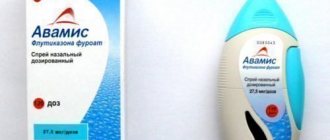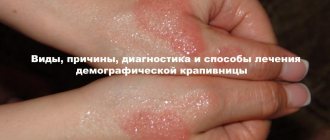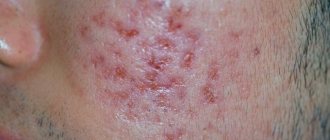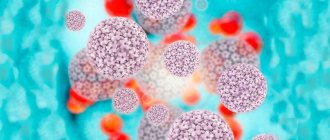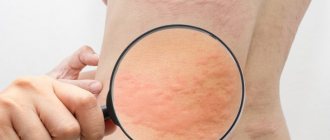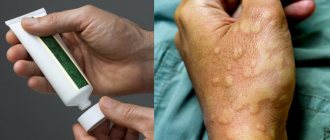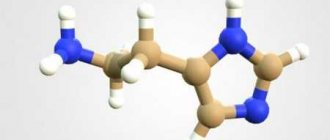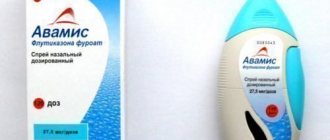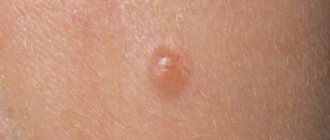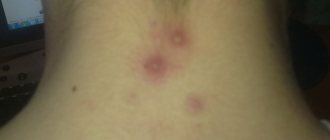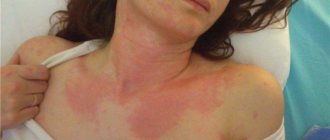Urticaria is an allergic skin disease that appears as red spots and severe itching. The rash may develop into blisters. The causes of this pathology are food or external allergens that come into contact with the skin with pollen or cosmetics. Generalized urticaria is characterized by diffuse rashes that affect the entire body; there are no clear foci of the disease. It can occur suddenly or be chronic. Without proper treatment, the disease can be complicated by Quincke's edema, which threatens the patient's life. Treatment is aimed at eliminating the allergic reaction and increasing the body's overall resistance.
Varieties
There are several classifications of the pathology that causes skin rashes.
Types of urticaria depending on the duration of the disease:
- Acute (up to 6 days).
- Chronic.
- Episodic.
If the duration of the rash is more than 6 days, the pathology is considered chronic . However, an important factor in the classification of forms of the disease is the division into groups due to the cause of occurrence.
Types of rash depending on etiology:
- physical,
- cholinergic,
- dermographic,
- reaction to cold
- response to mechanical stress,
- aquagenic,
- reaction to the sun
- vibration,
- allergic,
- reaction to an unknown factor.
Determining the cause of urticaria is the first stage of further treatment of the patient and the selection of treatment methods. The differences between the forms of rashes can be seen in the photo:
Content
Definition and general information [edit]
Drug-related pigmentation is primarily a cosmetic problem.
Etiology and pathogenesis[edit]
The mechanisms of occurrence of these pigment disorders are different. With rare exceptions, such changes on the skin are not a manifestation of an allergy to the drug, but they turn out to be the basis for the interaction of the skin with the drug during long-term use. Medicines with pigment-forming properties include chlorpromazine, fluorouracil, amiodarone, psoralen, etc. Pigmentation can be caused by deposits of heavy metals in the skin: bismuth, arsenic, mercury, etc.
Clinical manifestations[edit]
This type of hyperpigmentation often has a grayish-blue tint as substances accumulate in the dermis. You should also remember about chronic alcohol intoxication, which leads to hyperpigmentation of the skin.
Generalized skin rash caused by drugs and medications: Diagnosis[edit]
Differential diagnosis[edit]
Generalized skin rash caused by drugs and medications: Treatment[edit]
Prevention[edit]
Other [edit]
Synonyms: Drug Rash with Eosinophilia and Systemic Symptoms, drug rash with eosinophelia and systemic manifestations
DRESS syndrome is a hypersensitivity reaction characterized by a generalized skin rash, fever, eosinophilia, lymphocytosis and visceral lesions (hepatitis, nephritis, pneumonitis, pericarditis and myocarditis), and in some patients, reactivation of human herpes virus 6.
Manifestation usually occurs 2-6 weeks after drug administration. DRESS syndrome is most often caused by taking anticonvulsants and sulfonamides, but also allopurinol, cyclosporine, azathioprine, gold salts and antiviral drugs.
Manifestations of DRESS syndrome may persist for several weeks after discontinuation of the drug.
Urticaria is the main clinical sign of many allergic diseases, which manifests itself as a diffuse or limited rash in the form of blisters and papules of various sizes. Their appearance is accompanied by itchy skin. Generalized urticaria can occur as an independent disease or be a symptom of other diseases that differ in the mechanism of development and origin.
It is characterized by large areas of rashes, sometimes covering the entire human body. This type can pose a threat to the patient’s life, since generalized urticaria is often accompanied by Quincke’s edema. ICD-10 L50 is a disease code in the International Classification of Diseases (2018).
Causes
The causes of a generalized rash include:
- Bites of blood-sucking insects.
- Allergens (contact).
- Cosmetics.
- Allergenic products.
- Caustic chemicals.
- Use of medications.
- Cold or warm.
- Contact with water on the skin (reaction to impurities).
- Disorders of the gastrointestinal tract and thyroid gland.
- Autoimmune diseases.
- Fungal or viral infection.
- Infection with Helicobacter pylori in the case of gastritis or the development of stomach and intestinal ulcers.
- Helminths.
- Malignant diseases of the lymphoreticular system (chronic form of lymphocytic leukemia).
The influence of food allergens or medications that can cause a rash leads to the appearance of an acute form of the disease, while chronic rashes (caused by exposure to water or temperature) can persist for a long time.
Nonspecific irritants
Acute generalized urticaria may result in “nonspecific” mast cell responses in the absence of an allergen. For example, for radiocontrast agents.
With urticaria, concomitant systemic anaphylactic signs may occur: wheezing, laryngeal edema, convulsions, diarrhea, hypotension.
Acute viral diseases in children are accompanied by a generalized rash, as is the use of certain antibiotics, opiates, nonsteroidal anti-inflammatory drugs, and angiotensin-converting enzyme inhibitors. Hepatitis B, infectious mononucleosis, and helminthic infestations are associated with widespread rashes.
Signs of illness
Generalized urticaria has characteristic symptoms:
- skin redness,
- the appearance of blisters,
- swelling of the dermis,
- itching (intensifies in the evening),
- burning, pain.
The external signs of skin rashes may vary depending on the cause of the rash.
Hives can spread over all human skin, while neighboring blisters merge into larger formations.
The spots change their location on the skin or appear in neighboring areas of the epidermis. However, it is known that urticaria does not appear on the surface of mucous tissues. Associated symptoms may develop:
- general weakness, fatigue,
- increase in body temperature,
- chills,
- decreased appetite,
- joint pain,
- nausea, vomiting,
- bleeding from the nose.
An ambulance should be called if:
- The patient's blood pressure dropped significantly.
- Signs of suffocation appeared.
- There is pain in the abdominal area.
- The patient lost consciousness.
- Swelling of the mucous membranes was detected.
A dangerous consequence is anaphylactic shock.
Symptoms
For systemic urticaria, the symptoms are quite typical:
- sudden appearance of red blisters all over the body;
- skin itching, which especially intensifies in the evening;
- swelling of inflamed skin;
- burning and pain.
The main morphological sign of the disease is blisters of different diameters, which can merge into one red spot. The blisters have raised edges and represent swelling limited to the papillary layer of skin with an elevated surface.
The rash resembles extensive nettle burns. They quickly spread throughout the body and, merging, form an irregularly shaped spot that occupies a large area. A generalized rash rarely appears on the lips and mucous membranes. Usually within 1-2 days the rash disappears in some places, but multiple “rashes” appear in other areas. Sometimes there is a bullous and hemorrhagic form of systemic urticaria.
The disease is dangerous due to its severe course. The patient may suffer from:
- chills;
- temperature increase;
- malaise;
- loss of appetite;
- joint pain;
- nausea;
- nosebleeds.
Diagnostics
Methods used to assess rashes:
- test for possible allergens (food, contact),
- tests for concomitant diseases through blood, urine and other tests,
- provocative tests (cold),
- testing for mechanical impact and loads,
- determination of response to waves of different lengths (solar factor),
- water exposure test,
- analysis for possible viral, fungal or bacterial infections,
- test for the presence of autoimmune diseases,
- skin biopsy.
After identifying the form of urticaria, the doctor prescribes a treatment method and preventive measures.
Provoking factors
The main causative factors for the development of the disease include food:
- meat and products made from it (mainly pork and beef);
- fish;
- smoked fish and meat;
- milk;
- chicken eggs;
- stone fruits and berries (strawberries, wild strawberries);
- red apples;
- melon;
- carrot;
- nutritional supplements;
- honey.
- antibiotics (usually penicillin group);
- non-steroidal drugs;
- sulfonamides;
- iodine preparations;
- vitamins C;
- Group B;
- antiseptics.
- water procedures;
- Sun rays;
- thermal and cold factors;
- poison of some insects.
In addition, provoking factors include: chronic fungal, viral and bacterial infections, intestinal dysbiosis, gastric pathology caused by the bacterium Helicobacter pylori, psychogenic factors, chemical cosmetics.
Treatment
To provide first aid to a patient, you can use drugs previously approved by a doctor, to which the patient has no obvious contraindications.
First aid medications include:
- Suprastin.
- Tavegil.
- Prednisolone (in case of Quincke's edema).
Many antiallergic drugs are prohibited for use in children under 6 years of age and in pregnant women, so you should carefully read the instructions before using them.
If the patient has serious contraindications for the use of medications or there is no pharmacy nearby, the following treatment methods can be practiced:
- gastric lavage,
- taking activated carbon,
- ointment with hydrocorizone,
- ointment with prednisolone.
If the cause of hives is a contact allergen, it is necessary to stop the influence of the irritant as soon as possible.
The following drugs are used in the treatment of urticaria:
- Zodak.
- Cetirizine.
- Advantan.
- Solcoseryl.
- Desitin.
- Bepanten.
The use of hormonal drugs is not recommended without special instructions from a doctor.
Prevention of urticaria
People who have a genetic predisposition to allergic diseases can avoid urticaria, and especially its generalized form, by completely changing their lifestyle and observing the following preventive measures:
- careful selection of food products, excluding those containing preservatives, dyes and other food additives;
- quitting smoking and alcohol;
- use of hypoallergenic cosmetic products;
- use medications only as prescribed by a doctor;
- ensuring normal intestinal function, preventing intoxication of the body;
- regular cleansing of the body;
- prevention of helminthiasis;
- avoiding nervous overload and stress;
- strengthening the immune system, taking vitamin complexes.
In addition, it is necessary to undergo regular medical examinations in order to promptly identify and treat any diseases and prevent them from becoming chronic.
Preventive recommendations
To prevent the development of urticaria, you should:
- adhere to healthy eating rules,
- reduce the amount of alcohol consumed,
- avoid allergenic foods,
- improve health through exercise, walking and moderate hardening,
- use complexes of vitamins and minerals,
- carry out regular cleaning of premises.
An important factor in preventing the development of acute or chronic forms of urticaria is a timely visit to the doctor in case of developing signs of allergy.
